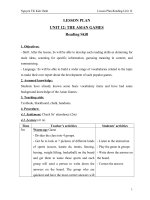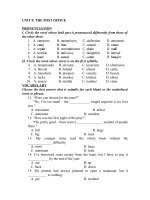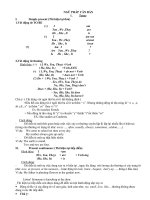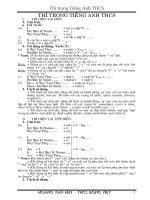phần ngữ pháp bài 12 tiếng anh 11
Bạn đang xem bản rút gọn của tài liệu. Xem và tải ngay bản đầy đủ của tài liệu tại đây (454.15 KB, 7 trang )
LESSON PLAN
Unit 12: THE ASIAN GAMES
Period 5: Language focus
Time allotted: 45 minutes
Class: 11B1 (Room: 17)
Date: 22/03/2011
Teacher in charge: Tong Nu Kieu Thu
Trainee teacher: Hoang Thi Hoai Giang
I. Aims: By the end of the lesson, students will be able to:
- know how to distinguish and pronounce sounds /str/, /skr/ and /skw/.
- master the use of relative clauses without relative pronouns.
- know how to work in pairs or in groups.
II. Teaching Aids and Materials: textbook, posters, handouts.
III. Procedure:
Stages/
Times
Activities
Work
arrangement
Warm-
up (5
minutes)
Game: SLAP THE PICTURES
- T divides class into 2 groups (Group A and Group B); each
group chooses 3 members
- T shows six pictures of these words: strawberry, stream,
scroll, screw, square, squash (Appendix).
- T gives some instructions: You will stand at an equal
distance from the black board. Listen to the word carefully. When I
read the word, the two students will run forward and slap the
picture on the board. The winner is the group with more correct
answers.
- T uses technique: STEP- BY- STEP to check the
instructions.
- T lets students play the game.
- T checks the result and declares the winner.
Group work
Presenta
-tion 1
1. Pronunciation:
- T hangs a poster with sounds:/str/, /skr/ and /skw/ on the
Whole class
(2
minutes)
board and introduces the sounds to the Ss:
/str/ /skr/ /skw/
strawberry
stream
screw
scroll
square
squash
Practice
1 (3
minutes)
- T reads the sounds two times, asks students to listen
carefully and repeat after the teacher.
Whole class,
individual
work
Presenta
-tion 2
(5
minutes)
* Omission of relative pronouns.
- T elicits the grammar point through following sentences:
1. I like the ring. Mary is wearing it.
=> I like the ring which Mary is wearing
or I like the ring Mary is wearing.
2. The flight was fully booked. I wanted to travel on it
=> The flight which I wanted to travel on was fully booked.
or The flight I wanted to travel on was fully booked.
- T gives the form: We can leave out the pronoun of the
relative clause when it is the objective of a verb or when it is the
objective of a preposition.
Whole class
Practice
(14
minutes)
Activity 1: Tick the sentences in which the relative pronoun can
be omitted.
- T gives some instructions: Work in pairs. Read the handout.
Tick the sentences in which the relative pronoun can be omitted in 3
minutes.
- T uses the technique STEP- BY- STEP to check the
instructions.
- T delivers the handouts.
Activity 1: Tick the sentences in which the relative
pronoun can be omitted.
(work in pairs)
Tick
1. I didn’t like the man who we met this morning.
2. I wasn’t interested in the things which they were
talking about.
3. I don’t know the girl who is sitting near the window.
4. The beef, which we had for lunch, was delicious.
5. The experiment which was conducted at the
University of Chicago was successful.
6. The photographs, which were published in the
newspaper, were very strange.
- T lets students do the activity 1 in 3 minutes.
- T asks students to give their answers and gives feedback.
Feedback:
Activity 1: Tick the sentences in which the relative
pronoun can be omitted.
(work in pairs)
Tick
Pair work
1. I didn’t like the man who we met this morning.
√
2. I wasn’t interested in the things which they were
talking about.
√
3. I don’t know the girl who is sitting near the window.
4. The beef which we had for lunch was delicious.
√
5. The experiment which was conducted at the
University of Chicago was successful.
6. The photographs, which were published in the
newspaper, were very strange.
Activity 2: Combine the sentences.
- T gives some instructions: Work individually. Read the
sentences. Combine the two sentences into one sentence with
relative clause without relative pronoun in 5 minutes.
- T uses the technique STEP- BY- STEP to check the
instructions.
- T delivers the handouts.
Activity 2: Combine the sentences. Use relative clauses without
relative pronouns.
1. Most of the classmates couldn’t come. He invited them to
the birthday party.
2. The short stories were very funny. John told them.
3. The dictionary is expensive, but very interesting. I bought
it yesterday.
4. I enjoy my job because I like the people. I work with
them.
5. The dinner party wasn’t very enjoyable. We went to it.
6. The house is not in good condition. We are living in it.
- T gives an example:
Ex: 1. Most of the classmates he invited to the birthday party
couldn’t come.
- After 5 minutes, T asks students to give their answers and
gives feedback.
Feedback:
1. Most of the classmates he invited to the birthday party
couldn’t come.
2. The short stories John told were very funny.
3. The dictionary I bought yesterday is expensive, but very
interesting.
4. I enjoy my job because I like the people I work with.
5. The dinner party we went to wasn’t very enjoyable.
6. The house we are living in is not in good condition.
Produc-
tion (10
minutes)
Activity 3: Write- it- up
- T gives some instructions: Work in groups. Choose a group
leader and a secretary of each group. Make sentences about your
class in 7 minutes. Use relative clauses without relative pronouns.
The group with more correct sentences will be the winner.
- T uses the technique SAY- DO- CHECK to check the
instructions.
- T gives an example: Tơ is the monitor I like most in our
class.
- T lets students do the activity 3 in 7 minutes.
- T goes around the class to help if necessary.
- After 7 minutes, T asks students to fix their paper onto the
board and gives comments.
Home-
work (5
minutes)
Homework:
- T asks students to do the following exercise in their
notebook.
Homework: Tick the sentences in which the relative pronoun
can be omitted.
1. What was the name of the man who you met yesterday?
2. The table that was broken has now been repaired.
3. Do you know the girl who he is talking to?
4. This is the novel that I’ve been expecting.
- T delivers the handouts.
Ex: 1: “who” can be omitted => put a tick near the number 1
Evaluation:
Whole class
- T asks students to give their ideas/ feeling of the class and the
teacher’s teaching method.
- T gives some comments on students’ learning attitude during the
class.
Phú Vang, ngày tháng năm 2011
Teacher in charge
Tống Nữ Kiều Thu
Appendix:
Picture:A Picture: C
Strawberry Stream
/str/ /str/
Picture: C Picture: D
Squash Square
/skw/ /skw/
Picture: E Picture: F
Scroll (cuộn giấy) Screw
/skr/ /skr/









